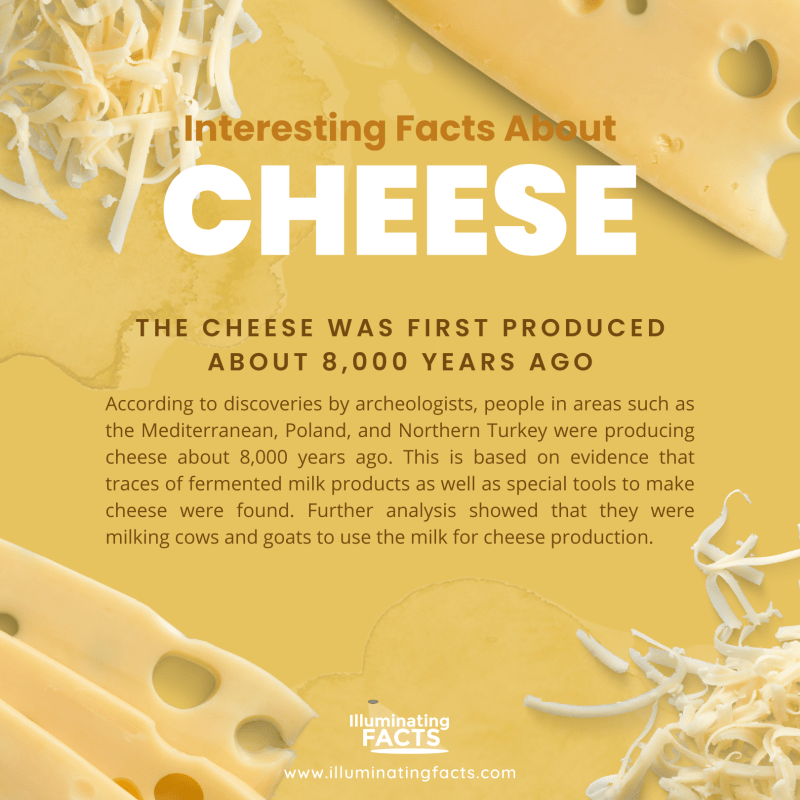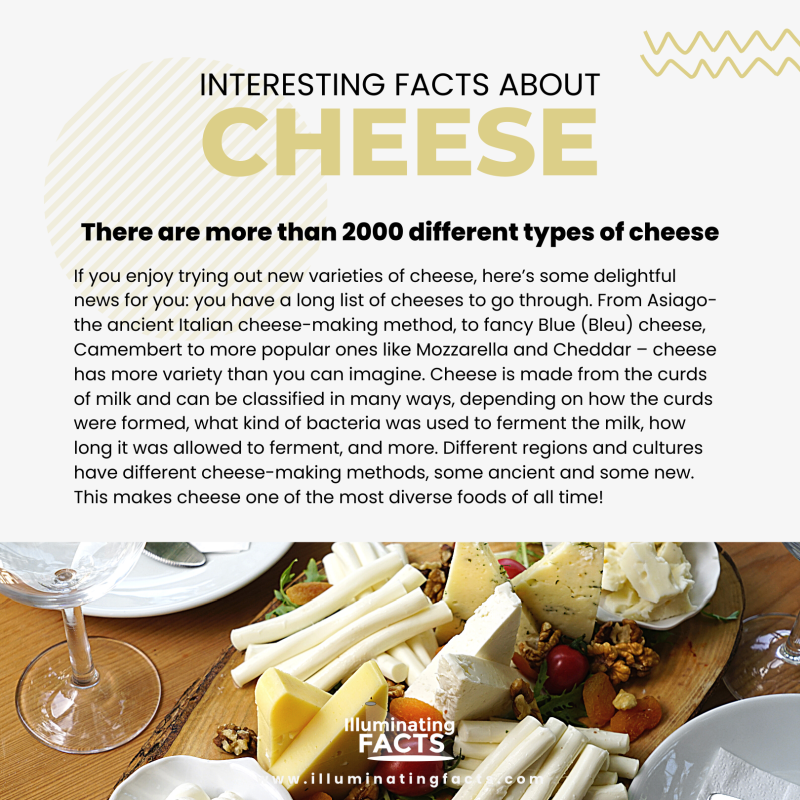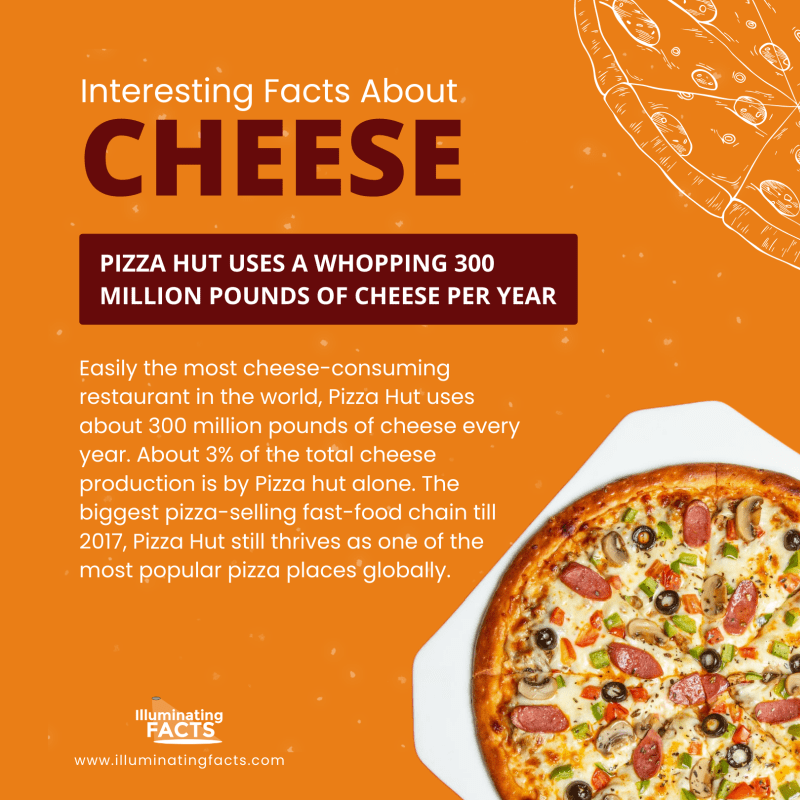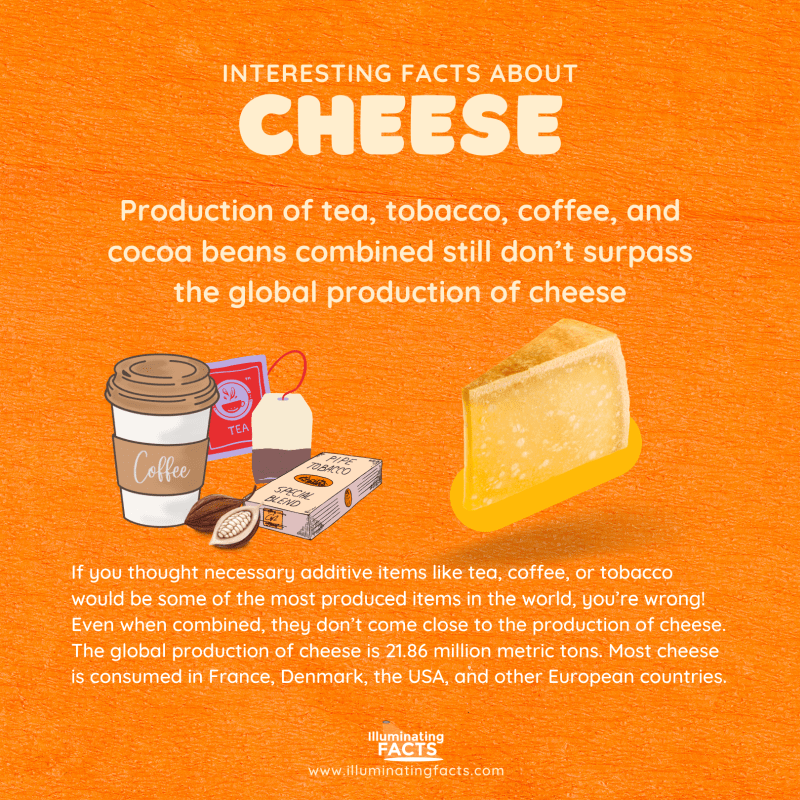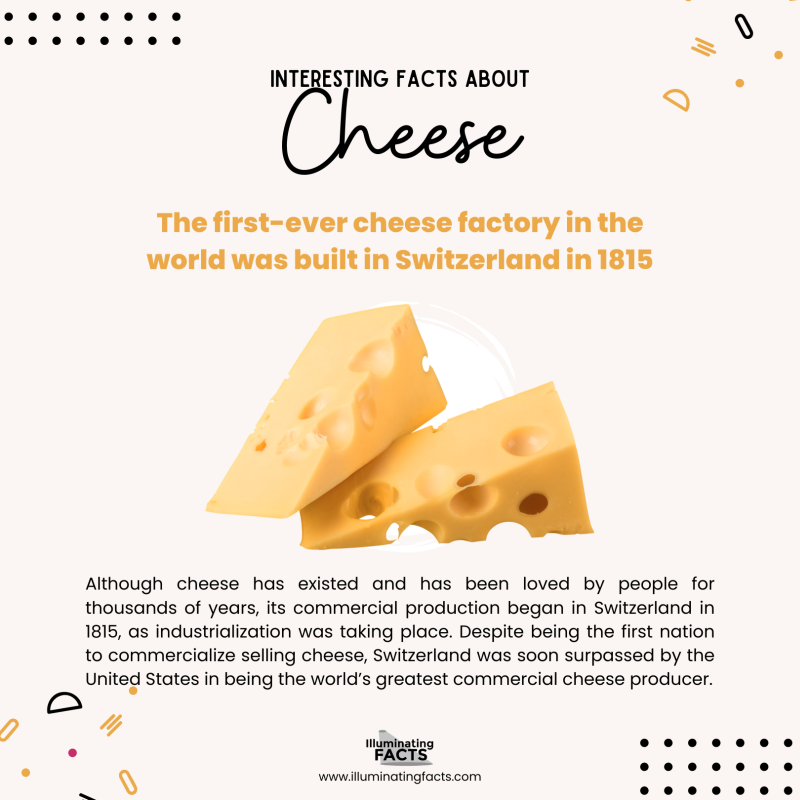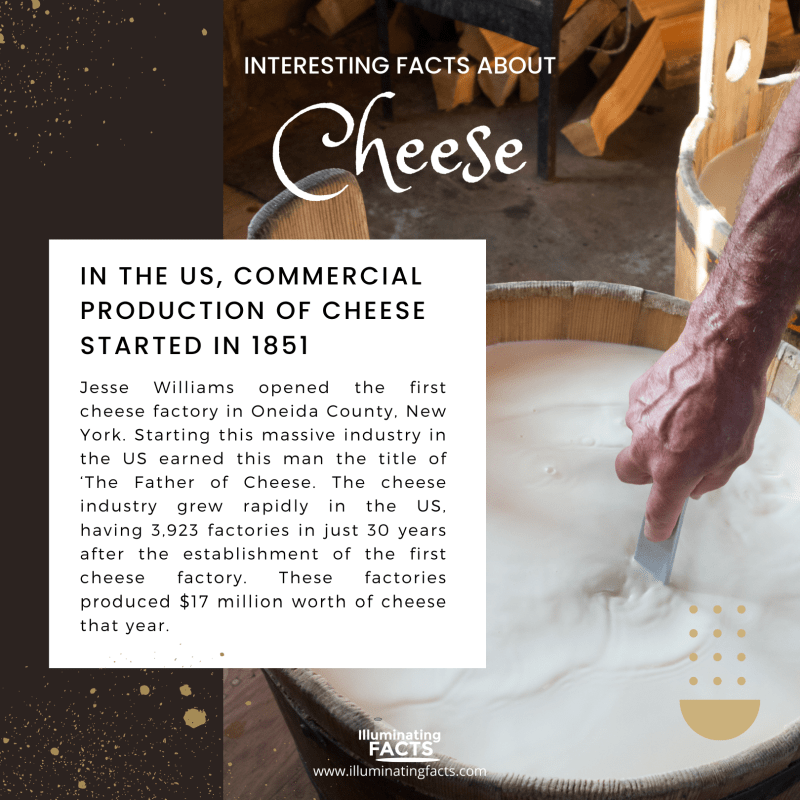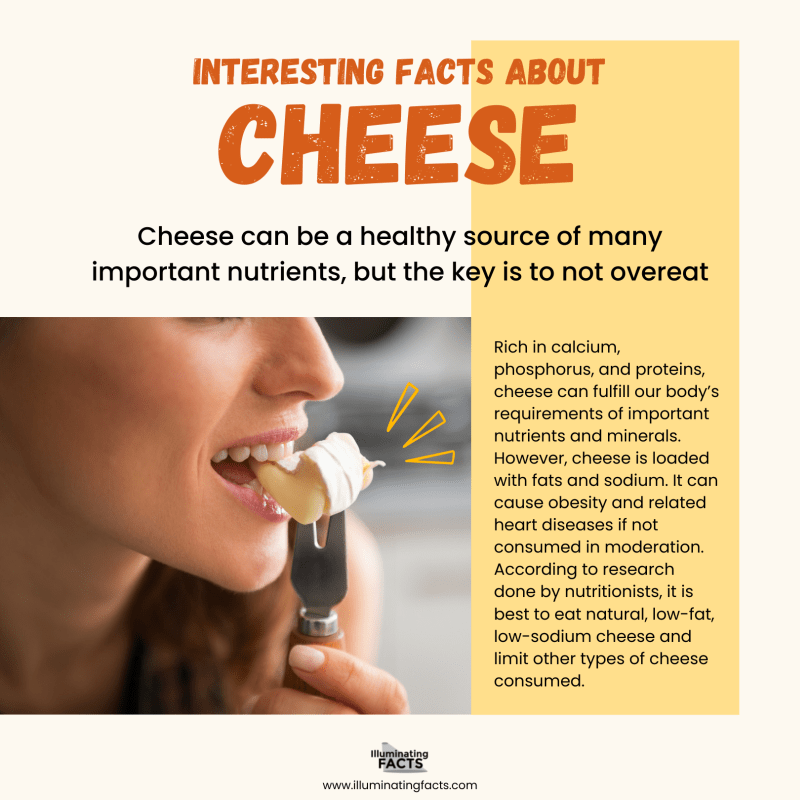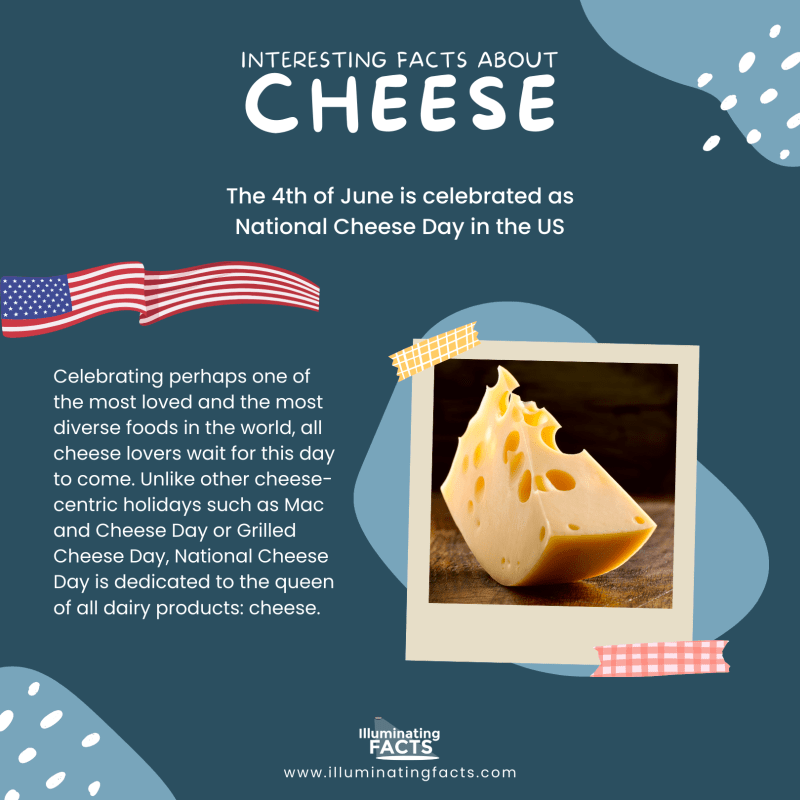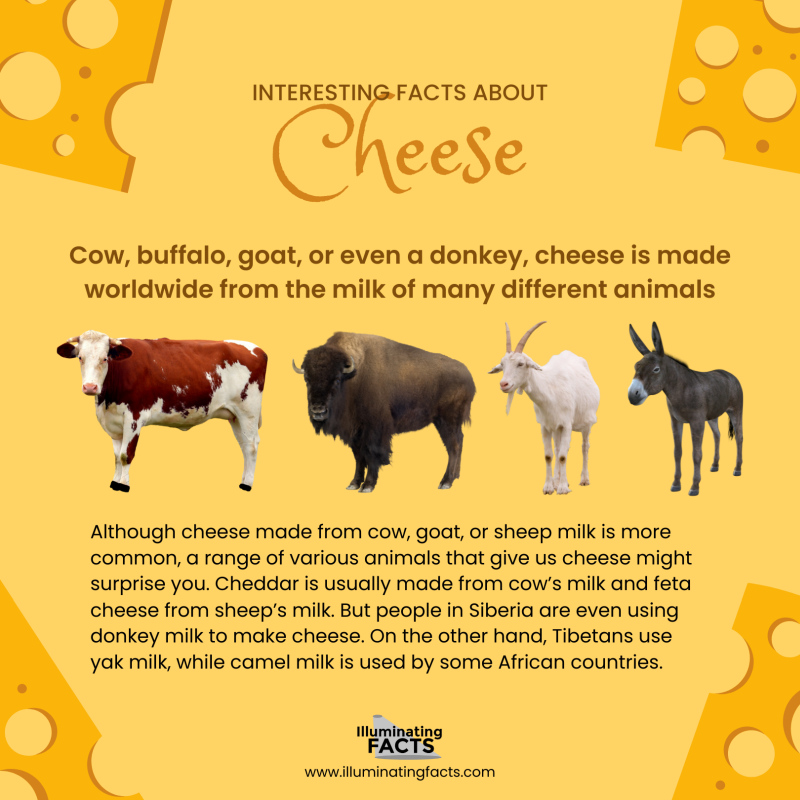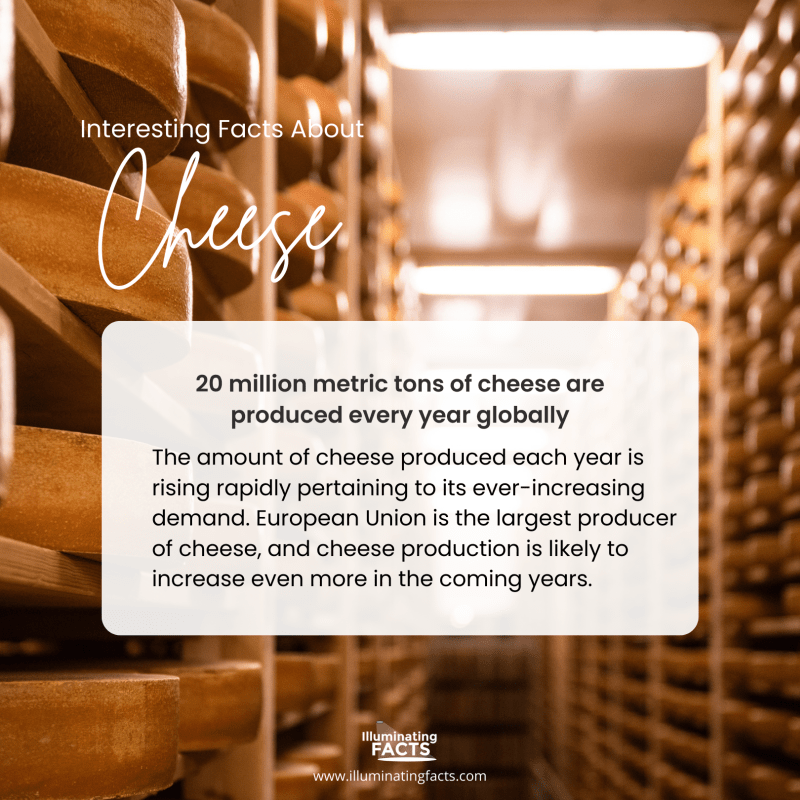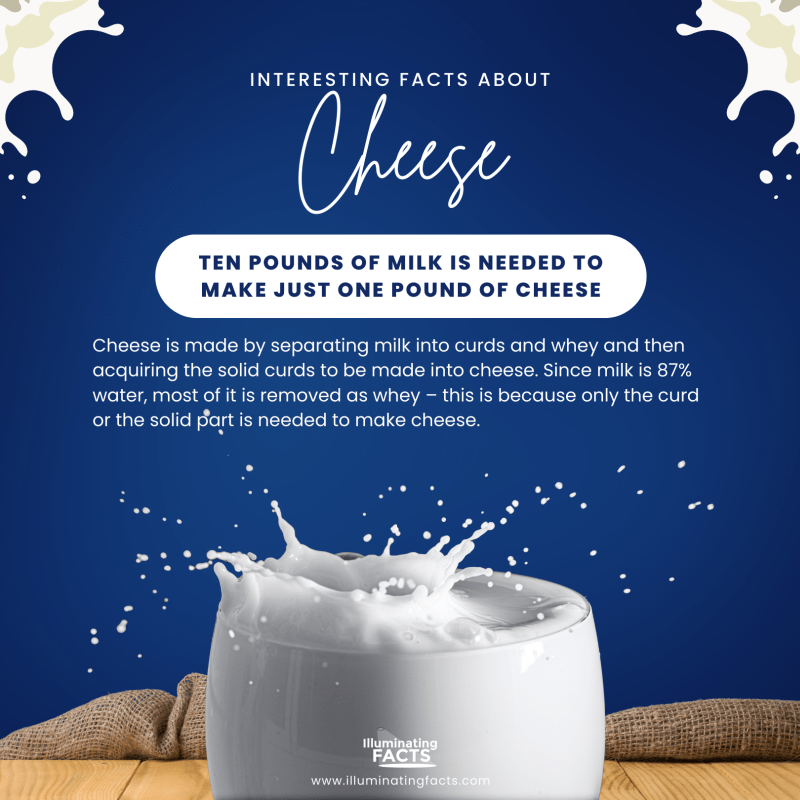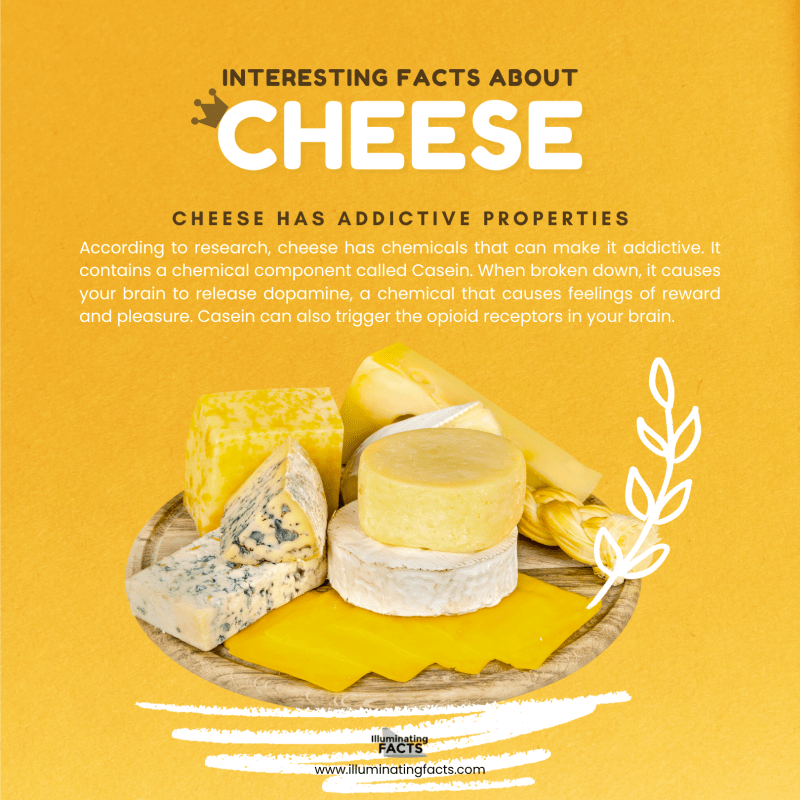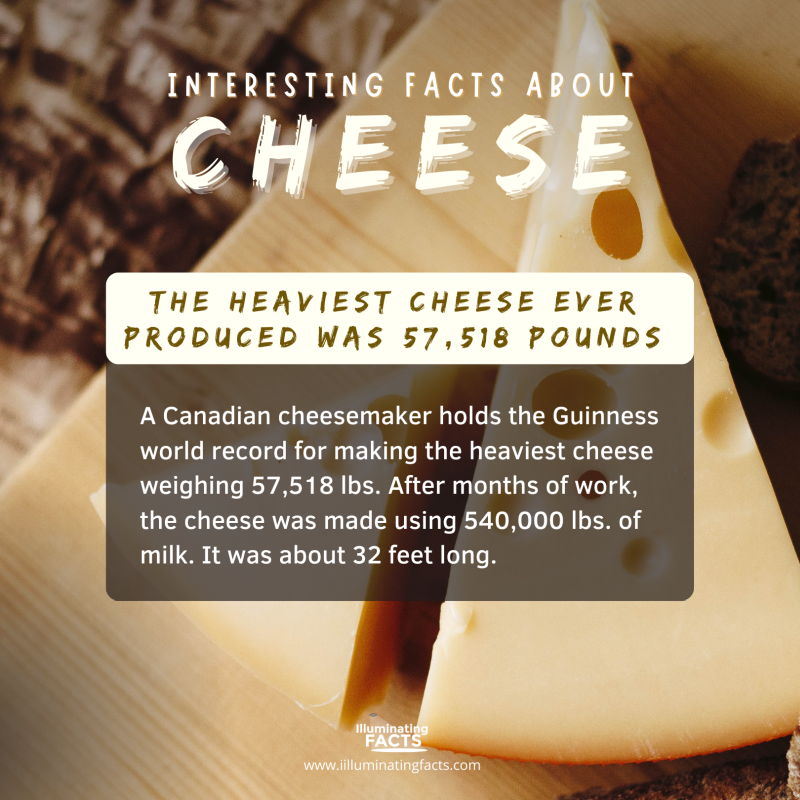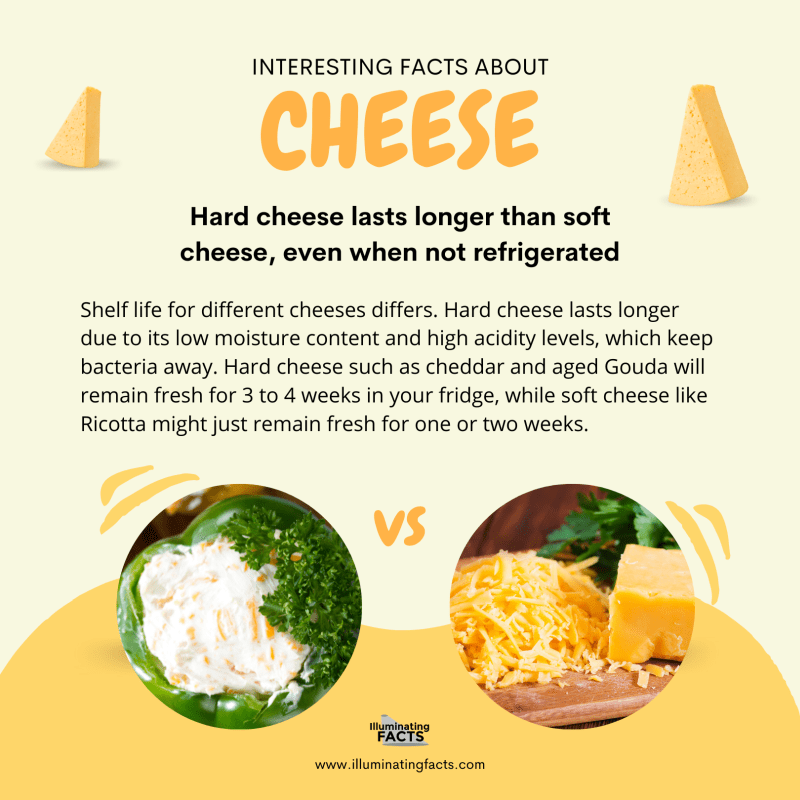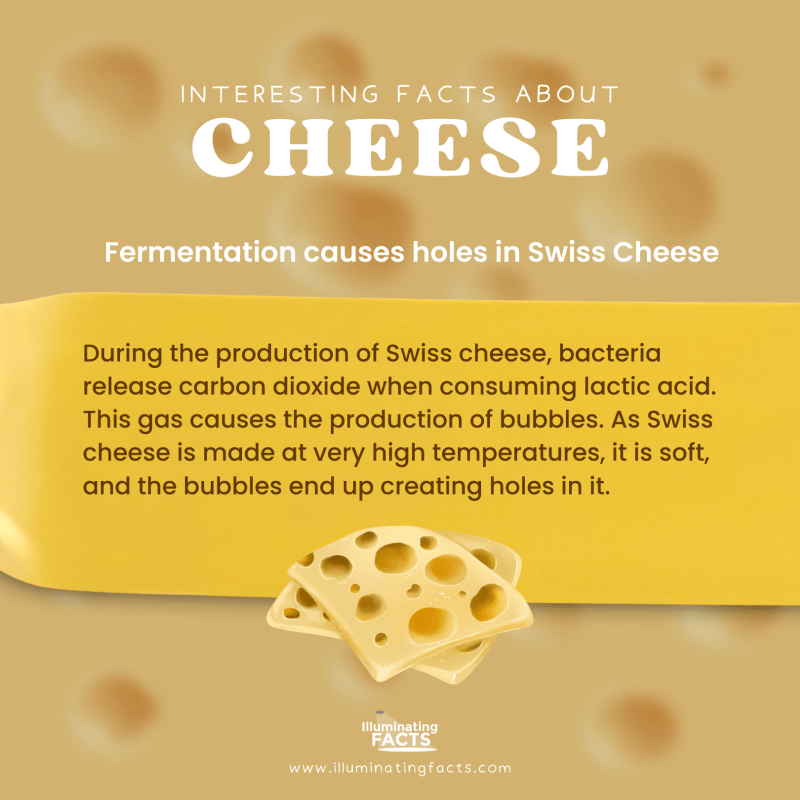Cheese has been around for thousands of years, and we’re not talking about just a few hundred like Cro-Magnon man’s cave paintings. Cheese goes back to the beginning of human time, dating as far back as 10,000 BC, evolving alongside humans. Its rich history is well defined in the literature, but these snippets of factoids may have escaped your attention before now. Let’s read about some of them below!
1. The Cheese was First Produced about 8,000 Years Ago
According to discoveries by archeologists, people in areas such as the Mediterranean, Poland, and Northern Turkey were producing cheese about 8,000 years ago.
This is based on evidence that traces of fermented milk products as well as special tools to make cheese were found. Further analysis showed that they were milking cows and goats to use the milk for cheese production. [1]
2. The Most Popular Cheeses
Mozzarella cheese is eaten the most, but cheddar is the most popular cheese in the world.
Picking out a favorite cheese is definitely not an easy task for cheese lovers! But the most popular cheese is determined by the number of sales.
Sharp-tasting, off-white and natural, cheddar cheese originated from England and is naturally the most popular there. The milky, soft mozzarella is more popular in other countries, including its place of origin, Italy, as well as France, Spain, and the US.
Brie, Feta, and Parmesan are among the other beloved cheeses around the globe. [2]
3. There are more than 2000 different types of cheese
If you enjoy trying out new varieties of cheese, here’s some delightful news for you: you have a long list of cheeses to go through. From Asiago- the ancient Italian cheese-making method, to fancy Blue (Bleu) cheese, Camembert to more popular ones like Mozzarella and Cheddar – cheese has more variety than you can imagine.
Cheese is made from the curds of milk and can be classified in many ways, depending on how the curds were formed, what kind of bacteria was used to ferment the milk, how long it was allowed to ferment, and more. Different regions and cultures have different cheese-making methods, some ancient and some new. This makes cheese one of the most diverse foods of all time! [3]
4. Pizza Hut uses a whopping 300 million pounds of cheese per year
Easily the most cheese-consuming restaurant in the world, Pizza Hut uses about 300 million pounds of cheese every year. About 3% of the total cheese production is by Pizza hut alone.
The biggest pizza-selling fast-food chain till 2017, Pizza Hut still thrives as one of the most popular pizza places globally. [4]
5. Production of tea, tobacco, coffee, and cocoa beans combined still don’t surpass the global production of cheese
If you thought necessary additive items like tea, coffee, or tobacco would be some of the most produced items in the world, you’re wrong! Even when combined, they don’t come close to the production of cheese. [5]
The global production of cheese was 21.86 million metric tons in 2021. Most cheese is consumed in France, Denmark, the USA, and other European countries.
6. The first-ever cheese factory in the world was built in Switzerland in 1815
Although cheese has existed and has been loved by people for thousands of years, its commercial production began in Switzerland in 1815, as industrialization was taking place.
Despite being the first nation to commercialize selling cheese, Switzerland was soon surpassed by the United States in being the world’s greatest commercial cheese producer. [6]
7. In the US, commercial production of cheese started in 1851
Jesse Williams opened the first cheese factory in Oneida County, New York. Starting this massive industry in the US earned this man the title of ‘The Father of Cheese.’
The cheese industry grew rapidly in the US, having 3,923 factories in just 30 years after the establishment of the first cheese factory. These factories produced $17 million worth of cheese that year. [7]
8. Cheese can be a healthy source of many important nutrients, but the key is to not overeat
Rich in calcium, phosphorus, and proteins, cheese can fulfill our body’s requirements of important nutrients and minerals. However, cheese is loaded with fats and sodium. It can cause obesity and related heart diseases if not consumed in moderation.
According to research done by nutritionists, it is best to eat natural, low-fat, low-sodium cheese and limit other types of cheese consumed. [8]
9. The 4th of June is celebrated as National Cheese Day in the US
Celebrating perhaps one of the most loved and the most diverse foods in the world, all cheese lovers wait for this day to come. Unlike other cheese-centric holidays such as Mac and Cheese Day or Grilled Cheese Day, National Cheese Day is dedicated to the queen of all dairy products: cheese.
Trying out all different kinds of cheese, from fresh cottage cheese to the Indian Paneer – this day holds some mouth-watering experiences cheese lovers can look forward to. [9]
10. Cow, buffalo, goat, or even a donkey, cheese is made worldwide from the milk of many different animals
Although cheese made from cow, goat, or sheep milk is more common, a range of various animals that give us cheese might surprise you.
Cheddar is usually made from cow’s milk and feta cheese from sheep’s milk. But people in Siberia are even using donkey milk to make cheese. On the other hand, Tibetans use yak milk, while camel milk is used by some African countries. [10]
11. 20 million metric tons of cheese are produced every year globally
The amount of cheese produced each year is rising rapidly pertaining to its ever-increasing demand. European Union is the largest producer of cheese, and cheese production is likely to increase even more in the coming years. [11]
12. Ten pounds of milk is needed to make just one pound of cheese
Cheese is made by separating milk into curds and whey and then acquiring the solid curds to be made into cheese. Since milk is 87% water, most of it is removed as whey – this is because only the curd or the solid part is needed to make cheese. [12]
13. Brie, blue cheese, and gorgonzola are all mold-ripened cheeses
Many people love to eat blue cheese, but not everyone is familiar with how it’s made. Many kinds of cheese are made using mold, usually in a type of bacterium called Penicillin. This gives the cheese a certain kind of smell and taste – the one we all love! [13]
14. In the ancient Roman Empire, some large houses used to have special kitchens, the Caseale, used primarily for making cheese
The cheese was loved as far back as the ancient Roman Empire. The Romans were skilled in making different varieties of cheese, and it held cultural significance for them.
The art of making cheese was certainly an important one for the Romans. We know this through the archeological discovery of some big Roman houses. They had a separate kitchen which was used solely for making cheese. [14]
15. Cheese can help prevent tooth decay
Some varieties of cheese, such as Cheddar and Mozzarella, are effective in fighting against cavities.
The lower the pH of our mouth, the higher the chance of developing cavities. According to research, our oral PH increases while chewing cheese, thus decreasing the chances of tooth decay. Moreover, eating cheese causes increased saliva production, which keeps the pH in our mouths balanced. [15]
16. The art of cheese making was brought to Europe by Asian travelers
Cheese-making was popular in Europe during Roman times, and it was brought to Europe by Asian travelers. It then spread to England and France from the Roman Empire.
While cheese-making gained popularity in the Middle East and Europe, the Americas had still not heard of it. In the 16th century, the pilgrims arrived in America when they brought the art of cheese making with them. [16]
17. Cheese has addictive properties
According to research, cheese has chemicals that can make it addictive. It contains a chemical component called Casein. When broken down, it causes your brain to release dopamine, a chemical that causes feelings of reward and pleasure. Casein can also trigger the opioid receptors in your brain. [17]
18. Lactose intolerant people can digest cheese
Although people with lactose intolerance cannot drink milk or eat other dairy products, cheese isn’t always a problem for them. It is because, during the cheese-making process, much of the lactose is broken down. More lactose breaks down during the aging process as well.
Hard cheese like parmesan and cheddar has lower lactose content, making them even safer for lactose-intolerant people. [18]
19. Edam cheese does not go bad for a very long time
A block of Edam cheese can last a very long time without freezing. It only becomes harder and does not spoil. Therefore, it was the best choice of cheese to take with you when traveling in olden times. [19]
20. The heaviest cheese ever produced was 57,518 pounds
Canadian cheesemakers at Argopur plant hold the Guinness world record for making the heaviest cheese weighing 57,518 lbs. After months of work, the cheese was made using 540,000 lbs. of milk. It was about 32 feet long. [20]
21. Hard cheese lasts longer than soft cheese, even when not refrigerated
Shelf life for different cheeses differs. Hard cheese lasts longer due to its low moisture content and high acidity levels, which keep bacteria away.
Hard cheese such as cheddar and aged Gouda will remain fresh for 3 to 4 weeks in your fridge, while soft cheese like Ricotta might just remain fresh for one or two weeks. [21]
22. Fermentation causes holes in Swiss Cheese
During the production of Swiss cheese, bacteria release carbon dioxide when consuming lactic acid. This gas causes the production of bubbles. As Swiss cheese is made at very high temperatures (79 degree Fahrenheit), it is soft, and the bubbles end up creating holes in it. [22]
23. The most popular cheese in the UK is Cheddar
Cheddar being the most popular in the UK isn’t surprising, as England is where it belongs to. It was originated from the English village of Cheddar in Somerset.
Cheddar cheese also makes up about half of all sales of cheese in the UK. [23]
24. The world’s smelliest cheese is named Vieux Boulogne
Vieux Boulogne, officially the world’s smelliest cheese, has a really pungent odor. The beer reacting with enzymes in the cheese makes the cheese give off such a stinky smell. [24]
25. The Most Cheese Consuming Country 2022

According to The International Dairy Federation, France holds the title for the most cheese consumed country in a year per capita. It is estimated around 57.9 pound per capita per year. [25]
Conclusion
All in all, cheese is a very versatile and important food and is considered a staple food in many cultures around the world. Over thousands of years, it has been made and eaten to satisfy a wide range of tastes, textures, and smells, from pungent and stinky to sweet and rich.
References
- Hints of 7,200-Year-Old cheese create a scientific stink. (2018, September 5). National Geographic. https://www.nationalgeographic.com/science/article/news-7200-year-old-cheese-ancient-food-chemistry
- Most popular cheeses in the world. (2019, June 21). World Food Atlas: Discover 16551 Local Dishes & Ingredients. https://www.tasteatlas.com/most-popular-cheeses-in-the-world
- Cheese. (n.d.). Home. https://www.dairysafe.vic.gov.au/consumers/dairy-foods/cheese
- Bria, O. (2021, June 15). The ridiculous amount of cheese Pizza Hut uses every year. Mashed.com. https://www.mashed.com/437563/the-ridiculous-amount-of-cheese-pizza-hut-uses-every-year/
- https://blog.aghires.com/cheese-facts/
- Where was the world’s first commercial cheese factory established?(2020, December 2). Grateful American® Foundation. https://gratefulamericanfoundation.com/where-was-the-worlds-first-commercial-cheese-factory-established/
- History of cheese. (n.d.). IDFA. https://www.idfa.org/history-of-cheese
- WareN, M., & L.D. (n.d.). Cheese: Types, health benefits, and risks. Medical and health information. https://www.medicalnewstoday.com/articles/299147
- National cheese day. (2021, August 20). Holidays Calendar. https://www.holidayscalendar.com/event/national-cheese-day/
- What milk can be used for making cheese. (2019, December 10). The Cheesemaking Workshop. https://thecheesemakingworkshop.com.au/milk-for-making-cheese/
- Cheese production worldwide 2015-2021. (2021, December 17). Statista. https://www.statista.com/statistics/1120911/cheese-production-worldwide/
- How much milk? — The Ag district. (2020, October 2). The Ag District. https://www.theagdistrict.com/blog/how-much-milk
- Chapter 36 – Surface Mold–Ripened Cheeses. (2017). In Paul L.H. McSweeney, Patrick F. Fox, David W. Everett (Ed.), Cheese (Fourth edition).
- The nibble: History of cheese. (n.d.). The Nibble Webzine Of Food Adventures. https://www.thenibble.com/reviews/main/cheese/cheese2/cheese-history-2.asp
- Cheese may prevent cavities. (2022, October 18). ScienceDaily. https://www.sciencedaily.com/releases/2013/06/130605130118.htm
- History of cheese. (n.d.). IDFA. https://www.idfa.org/history-of-cheese
- “Study reveals that cheese triggers the same part of the brain as many drugs”. (n.d.). Mount Sinai Health System. https://www.mountsinai.org/about/newsroom/2015/study-reveals-that-cheese-triggers-the-same-part-of-the-brain-as-many-drugs
- Lactose intolerance -14 ways to still love dairy. (n.d.). WebMD. https://www.webmd.com/digestive-disorders/ss/slideshow-dairy
- Edam, cheese and the city. (n.d.). Edam, Cheese and the City. https://www.edam.com/edam_cheese.htm
- Higgins, D., & The Post-Crescent. (2020, September 16). One presidential approval, two cheesemobiles and three times Wisconsin cheesemakers made national headlines for a mammoth cheese. Appleton Post-Crescent. https://www.postcrescent.com/story/life/food/2020/09/16/3-mammoth-cheeses-sealed-wisconsins-reputation-big-cheese/5659043002/
- 6 cheeses that can be left Unrefrigerated. (2022, October 10). Food Storage, Choices and Alternatives. https://foodsforantiaging.com/6-cheeses-that-can-be-left-unrefrigerated/
- Clark, S. (2020, February 27). Why does Swiss cheese have holes?The Conversation. https://theconversation.com/why-does-swiss-cheese-have-holes-130451
- British cheese: All you need to know. (2020, 4). Countryside. https://www.countrysideonline.co.uk/hobbies-and-leisure/food-and-cooking/british-cheese-all-you-need-to-know
- The big stink in France: The world’s smelliest cheese. (2018, May 25). France Today. https://francetoday.com/food-drink/the-worlds-smelliest-cheese/
- Cheese consumption by country 2022. (n.d.). 2022 World Population by Country. https://worldpopulationreview.com/country-rankings/cheese-consumption-by-country


